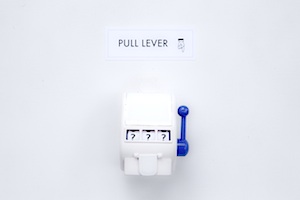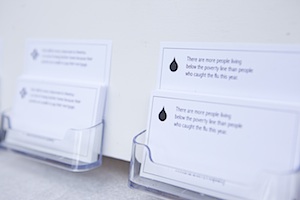

The artwork invites the viewers to pull a lever, which randomly returns a symbol. At the bottom of the artwork there are blocks of small print presenting one fact associated with each symbol.
Small print text is typically something we don't read, it stays outside of awareness, just like how people are unaware of the true inequality numbers. When they pull the lever and receive a symbol, they become connected in a personal way to one of the facts, the one from "their" symbol.
Each fact compares inequality statistics to mundane happenings, and in this way further connects the reality of inequality with real life. To continue this attachment, the viewers can take home a small card with the printed fact.
In the bottom of each card there is a link to an accompanying website. The site presents a digital version of the artwork. Besides extending access to viewers who cannot attend the exhibition in person, it also takes the interaction further, by asking a question: "do you think art can help reduce inequality?", and recording answers and comments. In this way the artwork will generate a new statistic, and the results will be made available after the exhibit.
www.lenara.com/inequality
Small print text is typically something we don't read, it stays outside of awareness, just like how people are unaware of the true inequality numbers. When they pull the lever and receive a symbol, they become connected in a personal way to one of the facts, the one from "their" symbol.
Each fact compares inequality statistics to mundane happenings, and in this way further connects the reality of inequality with real life. To continue this attachment, the viewers can take home a small card with the printed fact.
In the bottom of each card there is a link to an accompanying website. The site presents a digital version of the artwork. Besides extending access to viewers who cannot attend the exhibition in person, it also takes the interaction further, by asking a question: "do you think art can help reduce inequality?", and recording answers and comments. In this way the artwork will generate a new statistic, and the results will be made available after the exhibit.
www.lenara.com/inequality